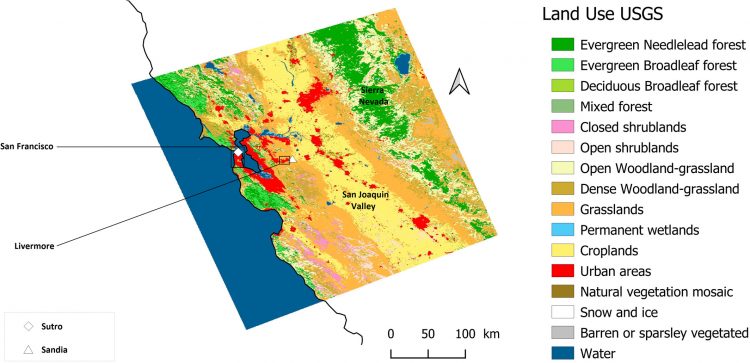Publication in JGR Atmospheres
2 July 2021
See full article/ Veure l’article complet: https://doi.org/10.1029/2020JD034106
English:
Cities are implementing additional urban green as a means to capture CO2 and become more carbon neutral. However, cities are complex systems where anthropogenic and natural components of the CO2 budget interact with each other, and the ability to measure the efficacy of such measures is still not properly addressed. There is still a high degree of uncertainty in determining the contribution of the vegetation signal, which furthermore confounds the use of CO2 mole fraction measurements for inferring anthropogenic emissions of CO2. Carbonyl sulfide (OCS) is a tracer of photosynthesis which can aid in constraining the biosphere signal. This study explores the potential of using OCS to track the urban biosphere signal. We used the Sulfur Transport and dEposition Model (STEM) to simulate the OCS concentrations and the Carnegie Ames Stanford Approach ecosystem model to simulate global CO2 fluxes over the Bay Area of San Francisco during March 2015. Two observation towers provided measurements of OCS and CO2: The Sutro tower in San Francisco (upwind from the area of study providing background observations), and a tower located at Sandia National Laboratories in Livermore (downwind of the highly urbanized San Francisco region). Our results show that the STEM model works better under stable marine influence, and that the boundary layer height and entrainment are driving the diurnal changes in OCS and CO2 at the downwind Sandia site. However, the STEM model needs to better represent the transport and boundary layer variability, and improved estimates of gross primary productivity for characterizing the urban biosphere signal are needed.
Català:
Les ciutats estan implementant el verd urbà addicional com a mitjà per capturar CO2 i esdevenir més neutre en carboni. No obstant això, les ciutats són sistemes complexos on els components antropogènics i naturals de CO2 interactuen entre si, i la capacitat de mesurar l’eficàcia d’aquestes mesures encara no s’aborda correctament. Encara hi ha un alt grau d’incertesa a l’hora de determinar la contribució del senyal vegetal, que a més confon l’ús de mesures de fracció molar per inferir emissions antropogèniques de CO2. El sulfur de carbonil (OCS) és un traçador de la fotosíntesi que pot ajudar a restringir la senyal de la biosfera. Aquest estudi explora el potencial de l’ús de l’OCS per fer un seguiment de la senyal de la biosfera urbana. Hem utilitzat el “Sulfur Transport and Deposition Model” (STEM) per simular les concentracions de l’OCS i el model de l’ecosistema “Carnegie Ames Stanford Approach” per simular fluxos globals de CO2 sobre l’àrea de la badia de San Francisco durant el març de 2015. Dues torres d’observació ens van proporcionar mesures d’OCS i CO2: la torre Sutro de San Francisco (a contravent de l’àrea d’estudi que proporciona observacions de fons), i una torre situada als Laboratoris Nacionals Sandia a Livermore (a la part baixa de la regió de San Francisco, altament urbanitzada). Els nostres resultats mostren que el model STEM funciona millor sota una influència marina estable, i que l’alçada i l’arrossegament de la capa límit estan impulsant els canvis diürns en OCS i CO2 a contravent (Sandia). No obstant això, el model STEM ha de representar millor la variabilitat de la capa de transport i límit, i es necessiten estimacions millorades de la productivitat primària bruta per caracteritzar la senyal de biosfera urbana.

Figure 1: Domain characterization based on United States Geological Survey land categories used for the simulation. The Sandia site is in the city of Livermore, 72 km downwind from the Sutro site located in San Francisco.

Figure 4: Observations from flasks collected at Sutro tower for atmospheric mole fractions of carbonyl sulfide and CO2 from October 2007 to December 2015.